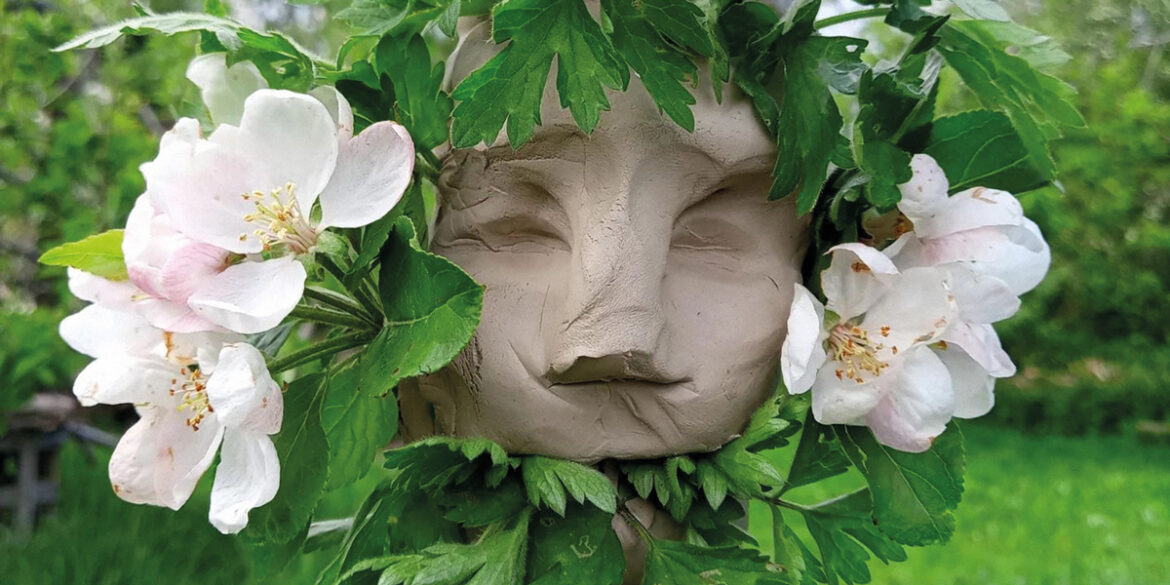Sowing seeds of hope for the local homeless community, we speak with Ruth Wood from Cambridge Cyrenians about
the incredibly transformative power of the allotment
Words PHOEBE HARPER
When it comes to finding an occupation that is at the same time rewarding and empowering, reams have been written about the benefits of gardening and spending time outside, particularly during the summer months when the weather can be kind.
Providing exactly that, local charity Cambridge Cyrenians has carved out a small patch of industry as a thriving community allotment, offering a slice of Eden to those looking to unearth and harness the wonders of nature.
The brains behind this social and therapeutic horticulture project is Ruth Wood. As manager of the allotment, Ruth facilitates horticulture, nature-based art and forest skills sessions for small groups of adults who are either currently or have been homeless and/or are vulnerable to homelessness. “I run sessions across two days a week, throughout the year, rain or shine,” she tells us. “Our project is a safe space where group members can build an important, supportive network. Working together regularly on practical, creative and meaningful tasks is one of the best ways to develop successful relationships with others. This kind of positive network can sometimes be lacking for people who have been homeless.”
Green shoots
The allotment began life as two plots on a local site in 2009, founded by the previous director of Cambridge Cyrenians, Brian Holman. Residents would come for a few hours a week to work together, but since Ruth took the helm of the project in 2012, the site has blossomed into approximately half an acre in size encompassing a diverse scope of growing spaces.
This has ensured that the plot sustains both volunteers and wildlife throughout the year. With both the yield of the plot itself, and the marked difference on those who get involved, the rewards are innumerable.
“Just some of the benefits for those involved in our project can be physical and mental health improvements, social inclusion, gaining life and employment skills, a sense of being part of something meaningful and valuable and a heightened understanding and knowledge of the local and wider environment,” Ruth observes.
Currently, the project encompasses 15 group members in total – some of whom have become regulars over the years and others who are occasional drop-ins – with anywhere between six and ten people at each session.
“I receive volunteer referrals from a wide range of homeless, mental health and statutory services. We’ve developed a rolling annual scheme of work, highlighting seasonal tasks and forest skills activities through the year and incorporating regular celebrations based on a traditional nature-based calendar.”
For instance, the allotment group celebrated this year’s summer solstice with an intimate gathering around the firepit, creating mandalas from found natural objects. In terms of the sessions themselves, these are often informed and indeed led by the members.
“I encourage group members to come up with their own suggestions for activities and we often invite people to come and facilitate creative projects,” shares Ruth. “Last year, we were lucky to have a professional willow worker visit and facilitate some weaving sessions using our own cut willow.”
Digging deep
What becomes clear from the group is the way in which an allotment provides a gateway for connection – whether it’s to nature, to yourself by finding purpose and meaningful occupation, or to others – be it other members of the group or the wider community of plot holders and local groups. “This grounding in the community can support a secure, meaningful lifestyle, proven to help move into and hold onto a permanent home.”
In addition, the allotment fulfils its essential purpose of providing produce rich with the nutrients often lacking for those who are experiencing homelessness, where getting access to healthy meals can be a major issue.
“Alongside the wildlife and forest skills areas, our large site includes two traditional vegetable-growing plots, a polytunnel,
herb patches, plus an orchard where we grow a variety of herbs, fruit and vegetables. This gives us all the opportunities to grow, harvest, share and learn to cook healthy food together.”
Looking to the allotment’s future, Ruth has been working on a development plan that includes an ecological impact assessment for the site, which centres on a drive to becoming off grid and gradually phasing out the use of fuelled equipment, building additional water collection and harvesting homegrown hazel and willow poles for building and plant supports.
On top of this, Ruth hopes to increase accessibility to the space, which is funded internally by Cambridge Cyrenians, through applying for donations and grants. “We would love to hear from local businesses, communities and organisations about development and funding ideas,” she concludes. “Currently, the project is only open to group members on two days of the week – and we would love to be able to facilitate sessions on several weekdays so that more individuals and groups can benefit from this space.”

